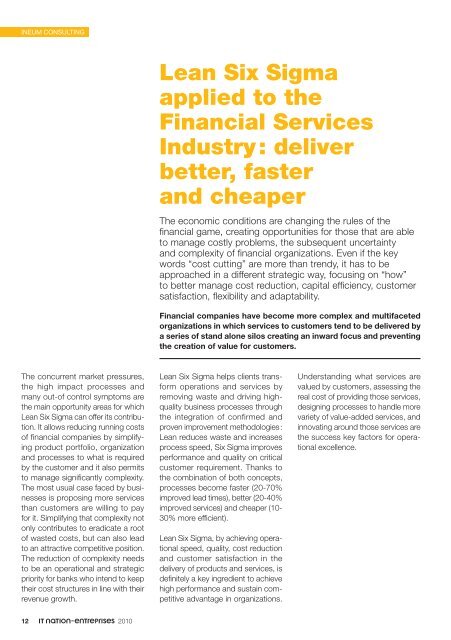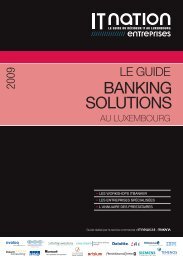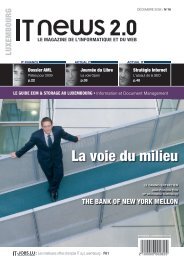CONSULTANCE ET DÃVELOPPEMENT - ITnation
CONSULTANCE ET DÃVELOPPEMENT - ITnation
CONSULTANCE ET DÃVELOPPEMENT - ITnation
Create successful ePaper yourself
Turn your PDF publications into a flip-book with our unique Google optimized e-Paper software.
ineum consulting<br />
Lean Six Sigma<br />
applied to the<br />
Financial Services<br />
Industry : deliver<br />
better, faster<br />
and cheaper<br />
The economic conditions are changing the rules of the<br />
financial game, creating opportunities for those that are able<br />
to manage costly problems, the subsequent uncertainty<br />
and complexity of financial organizations. Even if the key<br />
words “cost cutting” are more than trendy, it has to be<br />
approached in a different strategic way, focusing on “how”<br />
to better manage cost reduction, capital efficiency, customer<br />
satisfaction, flexibility and adaptability.<br />
Financial companies have become more complex and multifaceted<br />
organizations in which services to customers tend to be delivered by<br />
a series of stand alone silos creating an inward focus and preventing<br />
the creation of value for customers.<br />
The concurrent market pressures,<br />
the high impact processes and<br />
many out-of control symptoms are<br />
the main opportunity areas for which<br />
Lean Six Sigma can offer its contribution.<br />
It allows reducing running costs<br />
of financial companies by simplifying<br />
product portfolio, organization<br />
and processes to what is required<br />
by the customer and it also permits<br />
to manage significantly complexity.<br />
The most usual case faced by businesses<br />
is proposing more services<br />
than customers are willing to pay<br />
for it. Simplifying that complexity not<br />
only contributes to eradicate a root<br />
of wasted costs, but can also lead<br />
to an attractive competitive position.<br />
The reduction of complexity needs<br />
to be an operational and strategic<br />
priority for banks who intend to keep<br />
their cost structures in line with their<br />
revenue growth.<br />
Lean Six Sigma helps clients transform<br />
operations and services by<br />
removing waste and driving highquality<br />
business processes through<br />
the integration of confirmed and<br />
proven improvement methodologies :<br />
Lean reduces waste and increases<br />
process speed, Six Sigma improves<br />
performance and quality on critical<br />
customer requirement. Thanks to<br />
the combination of both concepts,<br />
processes become faster (20-70%<br />
improved lead times), better (20-40%<br />
improved services) and cheaper (10-<br />
30% more efficient).<br />
Lean Six Sigma, by achieving operational<br />
speed, quality, cost reduction<br />
and customer satisfaction in the<br />
delivery of products and services, is<br />
definitely a key ingredient to achieve<br />
high performance and sustain competitive<br />
advantage in organizations.<br />
Understanding what services are<br />
valued by customers, assessing the<br />
real cost of providing those services,<br />
designing processes to handle more<br />
variety of value-added services, and<br />
innovating around those services are<br />
the success key factors for operational<br />
excellence.<br />
12 2010
















